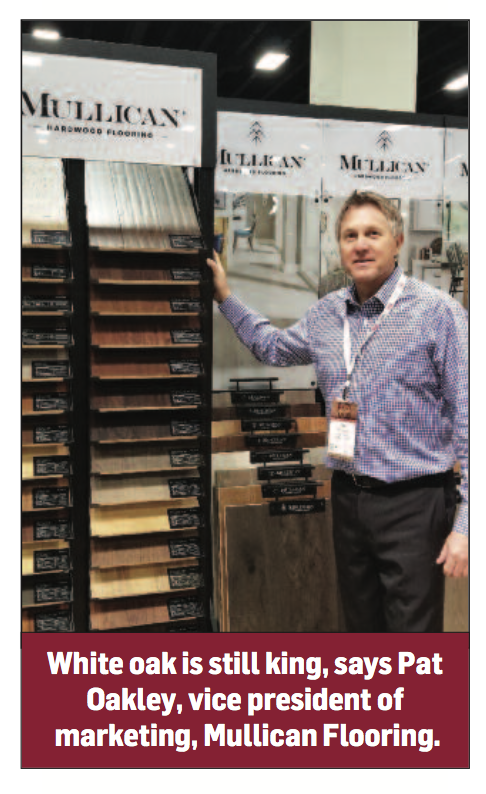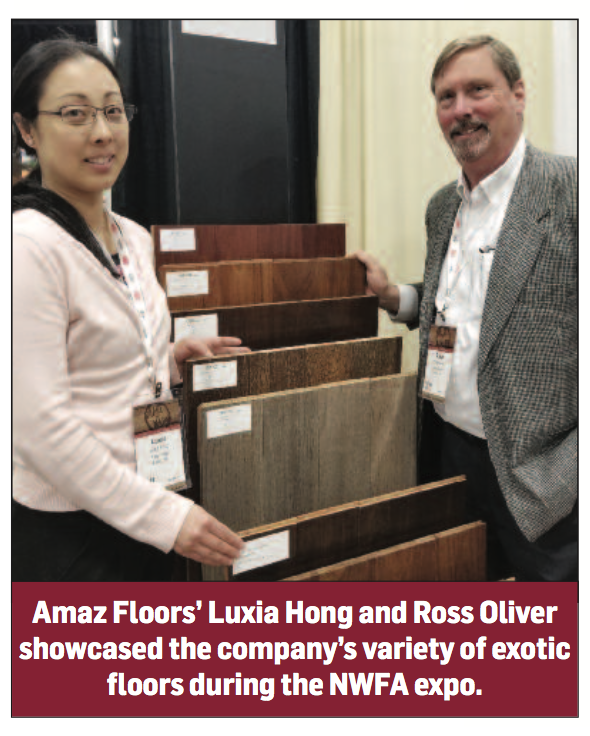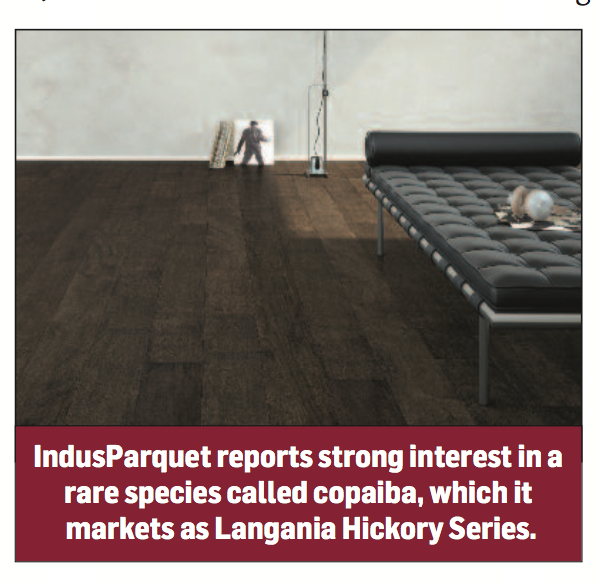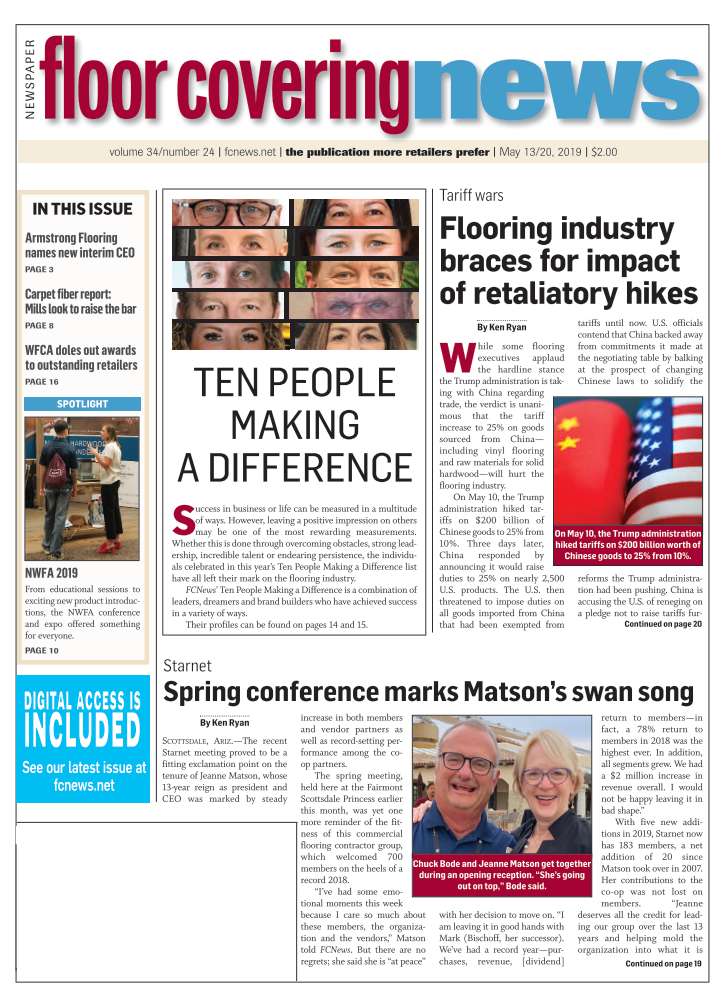May 13/20, 2019: Volume 34, Issue 25
By Reginald Tucker
 In the perennial battle between domestically produced hardwood and imported exotics, anecdotal information shows homegrown species are continuing to grow in popularity at a much faster rate than their tropical counterparts. At the same time, suppliers of hardwood flooring from South America, Southeast Asia and even parts of Africa said they are seeing a resurgence in demand for some of their products.
In the perennial battle between domestically produced hardwood and imported exotics, anecdotal information shows homegrown species are continuing to grow in popularity at a much faster rate than their tropical counterparts. At the same time, suppliers of hardwood flooring from South America, Southeast Asia and even parts of Africa said they are seeing a resurgence in demand for some of their products.
“In terms of domestics, white oak, red oak and hickory are still the drivers,” said Pat Oakley, vice president of marketing, Mullican Flooring. “We’re doing some different things with those species, such as light distressing and wire- brushing, to give them a more unique look.”
Industry experts primarily attribute the growing interest in domestic species to the combination of consumer trends away from the old “red’ exotics along with the color/texture characteristics domestic species pro- vide. “With hickory, for example, it’s the variation in color that generates interest and demand,” noted Brett Miller, vice president of education and training, for the National Wood Flooring Association (NWFA). “Even when you look at some of the imported species that are popular, they have that variance in color like hickory.”
Right alongside hickory are domestic variations of walnut. Proponents cite the species’ unique look, which has a high-end connotation compared to more mainstream species. “It has that nice, deep brown chocolate/almost purple color along with that light, blond sap-wood, which is a drastic variation,” Miller explained.
Domestic wood species have become more popular over the last several years in particular, given the frequent use of European white oak across many domestic and imported brands alike. This has created opportunities for manufacturers to differentiate themselves from the pack by utilizing various techniques. “Consumers are favoring American hardwood, but many still desire non-traditional visuals from their flooring,” said John Hammel, director of category management, hardwood and laminate, Shaw Floors. In particular, he cited the company’s new Repel Hardwood line offered in Relic and Landmark styles. “Domestic species like hickory and walnut answer that need.”
Given this rising popularity, it should come as no surprise that many of these domestic species are increasingly factoring into recent introductions and/or best- selling products from some of the industry’s major manufacturers. “Over the past few years, we have focused our introductions on these species with tremendous results,” said Dan Natkin, vice president, hardwood and laminate, Mannington. “There is something timeless about North American hardwoods. Smooth, elegant graining, great character, and the way they accept stain and other visual effects make them the prime choice for consumers.”
selling products from some of the industry’s major manufacturers. “Over the past few years, we have focused our introductions on these species with tremendous results,” said Dan Natkin, vice president, hardwood and laminate, Mannington. “There is something timeless about North American hardwoods. Smooth, elegant graining, great character, and the way they accept stain and other visual effects make them the prime choice for consumers.”
Mohawk has been using domestic white oak for many of its products combined with special proprietary manufacturing and finishing techniques to render different
visuals. Mohawk said it has also witnessed growing interest in species such as hickory and walnut, and it is adding more collections to meet those needs. “Consumers who are looking to be more unique are trying the hickories, walnuts and some other visuals to give it more flavor and variety in the mix,” said Adam Ward, senior director of wood and laminate.
Despite the strong allure of select domestic species, hardwood flooring importers believe there are still viable opportunities for exotics in the North American marketplace. Take IndusParquet, for example. The company has made a huge push over the past few years to broaden its product offering to appeal to a larger customer base.
“Although we still use only South American raw lumber, we have many more options for our consumers,” said Dan Gold, director of architectural sales. “For instance, in addition to our traditional, smooth, semi-gloss natural line, we can now stain, texture and use different gloss levels to meet the color trends of today.”
With trends moving away from the darker, dated, “deep red” species that define many imported species, especially those from South America, companies are adjusting their color range to conform to today’s trends toward lighter, warmer, cooler, brown/gray tones.
 “Two of our fastest growing product lines come from wood species we rarely used until just recently,” Gold said. “A species named tauari, which we market under the Brazilian Oak Series, and a species called copaiba, which we market under the Langania Hickory Series, have been great additions for us. Brazilian Oak has been especially successful with the 3⁄4-inch solid version and Langania Hickory in the wide plank engineered version. Those woods don’t have natural red tones like others in the traditional lineup.”
“Two of our fastest growing product lines come from wood species we rarely used until just recently,” Gold said. “A species named tauari, which we market under the Brazilian Oak Series, and a species called copaiba, which we market under the Langania Hickory Series, have been great additions for us. Brazilian Oak has been especially successful with the 3⁄4-inch solid version and Langania Hickory in the wide plank engineered version. Those woods don’t have natural red tones like others in the traditional lineup.”
Other exotic flooring suppliers are tweaking their finishing processes to appeal to more mainstream American consumers. Amaz Floors, for example, applies specialized staining techniques that mimic grain structures found naturally in other species. “With some of our species from Peru, we apply wirebrushing and a two- tone staining process to deliver a unique look,” said Ross Oliver, vice president of international marketing. “We also offer a species we call Peruvian pecan, which features contrasting colors. And for those customers who desire walnut (we don’t have that species in Peru), we offer jatoba but we put a chocolate stain on it. This gives it that variation you would normally see in American walnut.”
Ribadao Wood Boutique also reports a renewed interest in exotics, especially among those who purchased exotics in the past and are looking to expand into other rooms. During Domotex, Bruce Hammer, vice president of sales, North America, said people were asking for South American species. He also cited growing interest in some of the species the company imports from Africa, including wenge, sapele and iroko. “There’s just a rareness factor about it,” he said.

